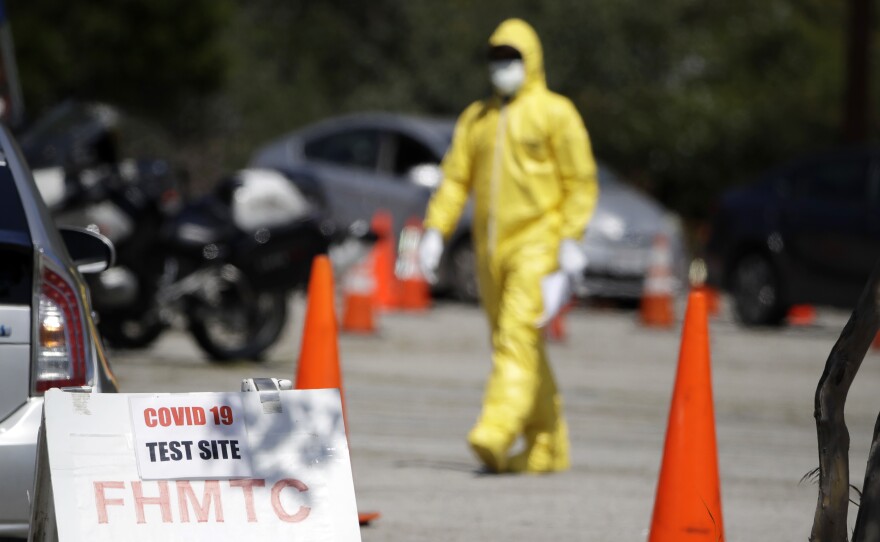California's extraordinary efforts to keep people home have bought the time needed to prepare for an expected peak surge of coronavirus cases in coming weeks, Gov. Gavin Newsom said Tuesday.
A spike of new cases has not come as quickly as expected, though Newsom was reluctant to say whether that means the impact on the state won't be nearly as dire as initially feared. Two weeks ago, Newsom said more than half the state's 40 million people could be infected under a worst-case scenario.
“To be truthful and candid, the current modeling is on the lower end of our projection as I talk to you today,” Newsom said at a news conference. “Very easily tomorrow I could say something differently, and that's why one just has to be very cautious about this.”
Under Newsom's direction, the state has been scrambling to add 50,000 hospital beds to its current 75,000 to ensure enough space for all potential patients during a peak.
It also put out a call Monday to retired doctors, nurses and medical and nursing school students to help out and had 25,000 people sign up online on the first day. The Board of Registered Nursing said nursing students could begin working right away.
RELATED: COVID-19 Cases Surpass 700 In SD County; Two New Deaths Confirmed
Newsom said the slower-than-forecast increase in cases means the peak is now likely in May.
Health officials have warned that as testing ramps up the number of cases will grow, in some cases very quickly. That is occurring but not as rapidly in California as some other states, including Louisiana and Michigan where cases have skyrocketed recently.
On Tuesday, there were more than 8,200 cases and at least 173 deaths reported in California, according to data kept by Johns Hopkins University. Michigan, which has 30 million fewer residents, had 7,600 cases and 259 deaths.
Los Angeles County, the state's largest with 10 million residents, has about one-third of the state's cases and reported its largest one-day increase Tuesday — 548, along with 10 deaths. The county saw 890 new cases over two days and the overall total has tripled in a week.
“The most important step to take right now is to stay home,” county health director Dr. Barbara Ferrer said.
Many have credited the state’s early action to issue stay-at-home orders — first in the San Francisco Bay Area two weeks ago and then a few days later in Los Angeles and the rest of the state — with successfully slowing the rise of cases.
Time will tell if those measures “flatten the curve,” meaning the rate of cases is slowed so it doesn’t exceed capacity of hospital beds. Instead of a graph with a steep curve to a peak number of cases surpassing available beds, the curve is gradual and flatter.
Dr. David Eisenman, director of the Center of Public Health and Disasters at the University of California, Los Angeles, said that while there isn’t enough information to show the curve is flattening, there are positive signs.
“There are many of us who see early indicators that make us cautiously optimistic,” Eisenman said. “But we could be wrong. At least these early indicators are not going the opposite way.”
Models created by the University of Washington also show a flatter curve and fewer deaths than expected, though the projection of about 5,000 deaths by June 1 underscores things will get significantly worse before improvement is seen.
Kaiser Permanente, which has 9 million members in its health care system in California, has seen a promising trend over the past two weeks since social distancing measures ramped up across the state.
The volume of phone calls from patients complaining of colds, coughs and flu — the leading indicator of future hospitalizations — has dropped 60% in the past two weeks from a peak of 14,000 calls a day to 5,000 a day, said Dr. Stephen Parodi, an infectious disease specialist at Kaiser.
Kaiser is treating 350 COVID-19 patients, which accounts for about 6-7% of available beds at its 36 hospitals in the state. The figure has remained relatively stable, Parodi said.
“What we’ve seen with hospitalization in both Northern California and Southern California is essentially a leveling off over the past week and a half,” Parodi said. "Which is in contrast to other systems in the United States where they’re seeing significant increases or even exponential increases and we’re not seeing that in California.”
Newsom and other officials say they are not taking anything for granted and don’t want residents to become complacent.
For most people, the coronavirus causes mild or moderate symptoms, such as fever and cough that clear up in two to three weeks. For some, especially older adults and people with existing health problems, it can cause more severe illness, including pneumonia and death.
On Tuesday, San Francisco and five surrounding counties extended shelter-in-place orders until May 3 and added new restrictions, including closing playgrounds, dog parks, public picnic areas, golf courses, tennis and basketball courts, pools, and rock climbing walls.
The new order also prohibits most residential and commercial construction.
"We are bending the curve," Santa Clara County Public Health Officer Dr. Sara Cody said at a news conference. “But it's not enough.”





